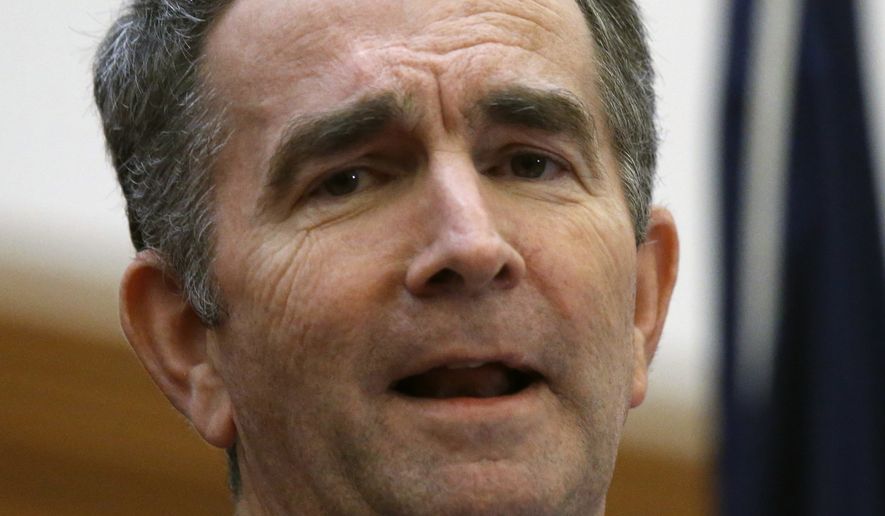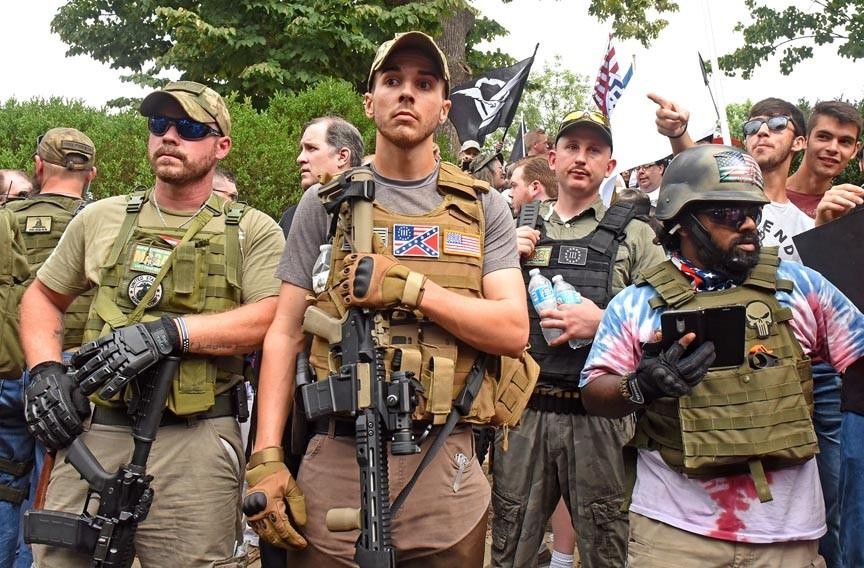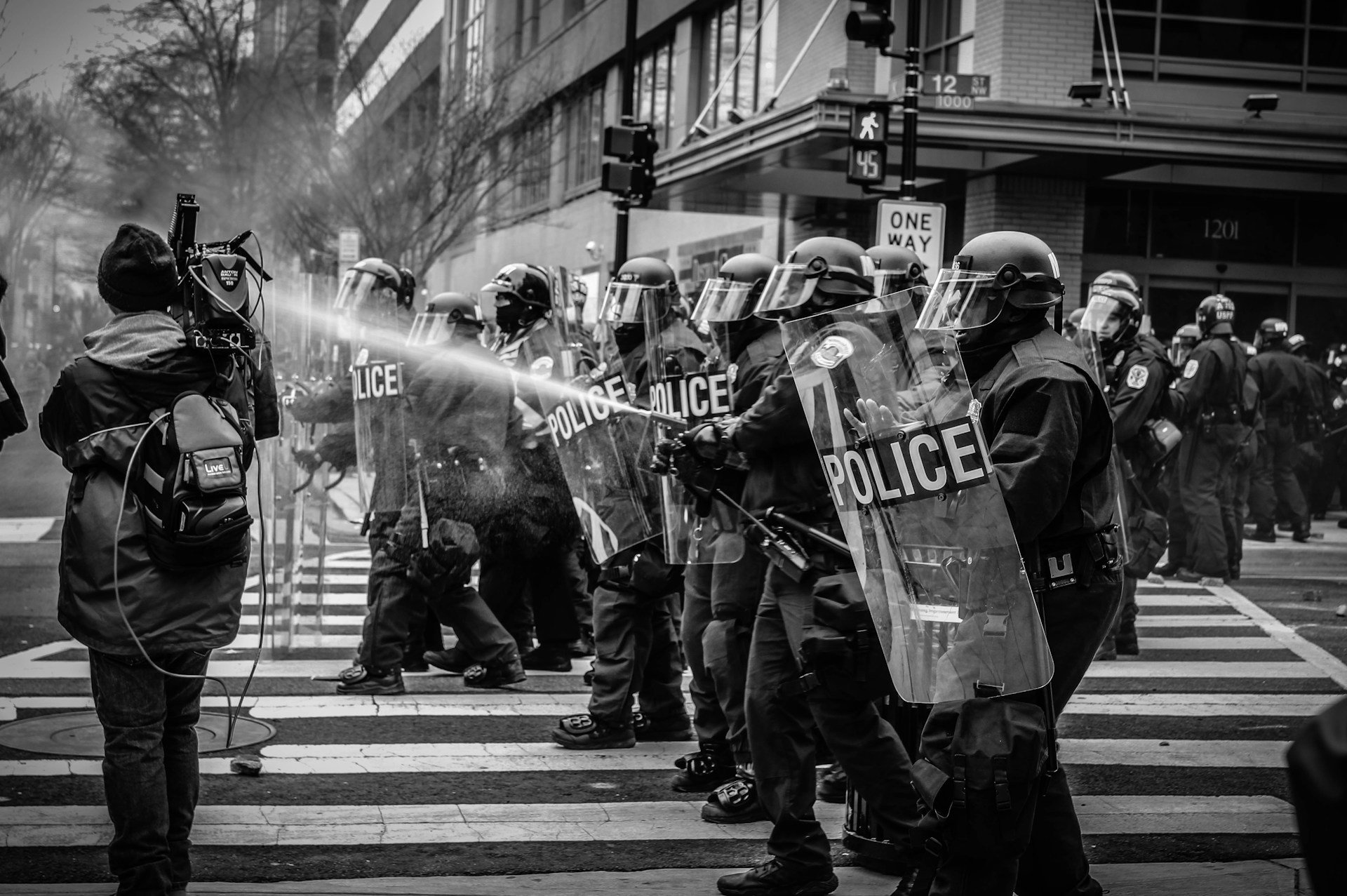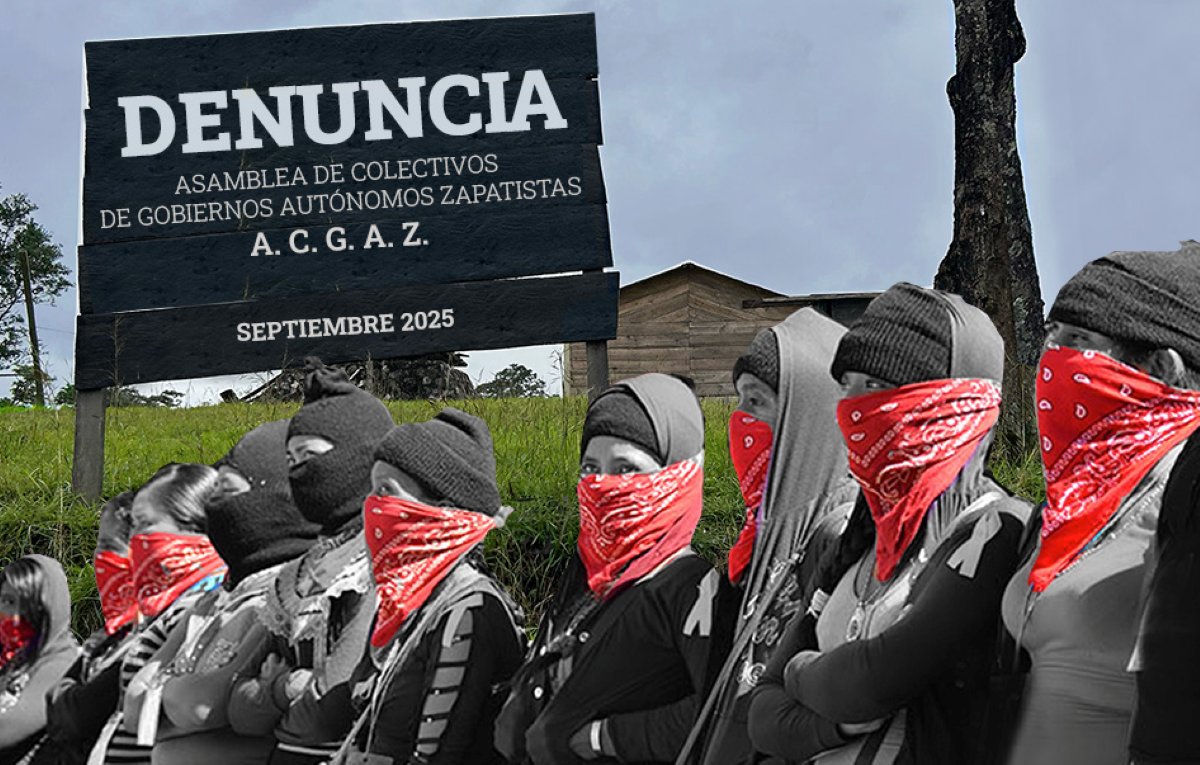Filed under: Critique, Southeast, The State

The following article from Red Strings and Maroons pushes back against both the liberal and conservative talking points surrounding the upcoming mass demonstration on January 20th against newly proposed gun reform legislation.
This January, Democrats took both chambers of the Virginia state legislature for the first time in twenty years. They won, in part, because of how they campaigned on the issue of gun control following the mass shooting at Virginia Beach that killed twelve people. Since early January, and in partnership with Democratic Governor Northam, they have been steadily moving forward on a series of new gun control measures. Taken together the bills being considered are monumental and sweeping in their scope, especially in relation to armed community defense. This coming Monday, January 20th, in Richmond, Virginia a large pro-gun demonstration has been scheduled in response.
Breaking News: Neo-Nazi group The Base releases statement on the arrests of their members today. @LCRWnews @IGD_News @RightWingWatch pic.twitter.com/T1nUoUOMYO
— Salish Black Flag? (@SalishBlackFlag) January 17, 2020
The New proposed legislation seeks to advance an “assault weapons” ban, an extreme risk protection order (otherwise known as a Red Flag law), a ban on “high capacity magazines,” binary triggers, bump stocks, and suppressors, a universal background check for the purchase and transfer of firearms – including private transactions, a limit on one firearms purchase per month, the ability of localities to ban guns in public spaces, a requirement to report lost or stolen firearms, the elimination of concealed carry or open carry of firearms at permitted events or events that would “otherwise be permitted,” and an expansion of existing Virginia Code on limiting and prosecuting “paramilitary activity.”
RESISTANCE IS BORN
Liberals and gun control advocates have widely celebrated the efforts and they are hoping for more than just success in Virginia. The legislative success of these efforts in Virginia could provide a roadmap for other states that turn blue in the next election, but serious questions about legality and most significantly, application and enforcement, remain. Though it’s been exciting for liberals, it’s jump-started a grassroots resistance from the other side of the aisle. Gun rights advocates and individual gun owners immediately went to work mobilizing people to pressure local governments to resist any new gun restrictions that may eventually be passed. On the State level, republican legislators have proposed new tough on crime bills with increased penalties and mandatory minimums, offering liberals an attractive compromise on gun control if this comes to an impasse. This is a historically effective strategy, as we will touch on later.
Resistance has also manifested itself in two extremely significant ways. First, it birthed the second amendment sanctuary movement, where counties and local townships passed resolutions keeping their law enforcement agencies from enforcing new gun restrictions, eliminating the budget for law enforcement to conduct such duties, and even the promise of deputizing citizens and creating a militia to resist outside authorities from enforcing new gun laws that go into effect. In effect, it’s dramatically increasing the communication between existing militias and the State elements which are sympathetic to their views. Their growing coordination outside the realm of demonstrations is an alarming development. (This reimagining of the “sanctuary movement” has now begun to spread, with several North Carolina counties following suit despite the absence of the legislative threat experienced by their northern neighbor.)
Secondly, it’s galvanized the militia movement across the nation. OATH KEEPERS are sending members to various localities to train people in firearms handling and security. Various Three Percenter (iii%) militias, among many other militia formations, are traveling to Virginia for the huge January 20 second amendment rally. Among the groups attending are some explicitly racist ones. The Georgia iii% Security militia, led by notable racist Chris Hill, and the Stokes County Militia of North Carolina, whose leader is part of Identity Dixie leadership, are just a few.
This rally is a golden opportunity for networking and recruitment, particularly for far right and explicitly fascist elements, seeking to relegitimize themselves after the ongoing backlash of the white supremacist defeat in Charlottsville. New militias in Virginia are forming and though that movement is often fractured with a lot of infighting, most are coming together to push back against a shared enemy.
THE RALLY – RVA J20
Much has been speculated on the possibility for violence during the January 20th rally in Richmond, Virginia organized by the Virginia Citizen Defense League. Governor Northam has even declared a state of emergency and banned firearms at the capitol ground in anticipation of potential violence. His stated reasoning is that he doesn’t want another Charlottesville and his law enforcement officials interpret the online rhetoric around the January 20th event as alarming. Admittedly, much online rhetoric from many militia folks and individual 2a people is gross and violent in nature but to be honest, that is the norm, the only shift here is not in content but volume. Before the emergency order, the idea that this would somehow turn into anything resembling Charlottesville was patently absurd. This rally isn’t the largest white nationalist gathering in decades, it hasn’t had a huge build up, no one is doing a counter demonstration that could be disruptive, and the few Left elements who are mobilizing are doing so in a seperate and non-confrontational capacity. Those folks are showing up to articulate an argument against gun restrictions as well.
Ironically, Northam’s order to remove guns from the capitol grounds may have significantly shifted the playing field. Before the order it was expected that the vast majority of 2a folks would be hanging out on the capitol grounds, clustered around social media personalities, their putative leaders, and comfortably proximate to the militia members that have been tasked with helping to keep everything civil and deescalated. Northam’s emergency gun ban essentially disperses the 2a demonstrators by denying them their central, symbolic public space through the temporary suspension of the very right they are assembling to defend (involving a lethal tool and potent political fetish object–namely, a gun), forcing rally goers who refuse to go unarmed to move to the outskirts of the capitol grounds, away from their leaders, and in closer proximity to the general public. Oddly, even as Northam claims to be attempting to avert the conditions that produced the riots in Charlottesville, he is setting up the possibility for angry, armed individuals to be moving aimlessly through the city’s center, colliding and shifting randomly with erratic law enforcement obstacles, counter-protestors, and random city inhabitants, some of whom will be likely totally surprised by these new, ominous figures populating their streets.
Northam’s order also has brought into focus a more defined and immediate enemy for the pro-gun movement that otherwise would have been more broad and abstractly defined. Whereas before the order it was Democrats in general and an amorphous group of anti-gunners and their legislation that were the target of pro-gun ire, neither of which are really within reach of direct confrontation or beneficial to physically confront, now it’s squarely the enforcement apparatus Northam’s going to use to implement his emergency order that are situated in stark opposition to the rally goers.
For leftists hoping to show up and publicly advance a different take on the entire gun control debate, Northam really just kicked the hornet’s nest. Rhetoric around violence against anyone some militia folks consider traitors and “Redcoats” is increasing (a recent fad among “patriots” is to cast their opponents as agents of a distant tyrannical government). Some folks are no doubt looking to take out their anger on an easily-identifiable target. Furthermore, the nature of this emergency order and it being directed straight at the militia movement almost feels like a challenge, a power struggle, and those challenges aren’t something that the militia movement really backs down from- its kinda their thing- for a stark example, please see the Bundy Ranch standoff with Federal agents in 2014.
With this shift in tensions and more explicit attempts by the Virginia government to restrict the freedoms of protestors, folks within the demonstration and on its outskirts should absolutely take more security measures, prioritize deescalation, avoidance, and help folks exiting stage left if the situation(s) gets heated or unpredictable. One thing is for sure, left folks aren’t dictating the pace or tenor of the day at all, so be smart.
Regardless of all that, the incentives for the 2a rally goers to remain peaceable is high. They are playing the electoral game and need to appear as legitimate as possible. Core to their argument is being law-abiding citizens. Antagonizing Mothers Demand Action members or even leftists on or off the capitol ground would no doubt be immediately seized on by the media and become an optics disaster for the rally organizers. As mentioned already, the militia movement is fractious with infighting, and now they’ve had to come together and act in a manner that doesn’t alienate the gun rights organizations they are partnering with (with deep financial and social ties to the gun industry and the Republican establishment) or the mass of gun-owning individuals who aren’t connected to a group but who are nonetheless mobilizing in significant numbers to oppose gun restrictions and need to experience a positive moment of collective action in order to bolster the active ranks of politically-engaged, financially generous gun owners who form the backbone of traditional gun rights organizations like the NRA. It’s rare that militia folks have a genuine audience with a potentially sympathetic public, they don’t want to lose that opportunity to gain credibility and be seen as a crucial component in remaking the fabric of everyday, local community life. Violence could mean losing public legitimacy and instigate further splitting amongst themselves. Groups that don’t toe the line will be alienated and dragged, no doubt.
The main possibilities for violence are some random altercations happening after the event. Folks familiar with being in contested space know that getting to and from an event, the times leading up to and shortly after a demonstration, are often the most dangerous. That’s where folks are vulnerable because they are not coordinated and hyper-vigilance alters the normal sense of security or restraint. Those are times that people are more easily targeted and less group control exists to divert confrontational behavior. The social barriers between people of opposing views become much less functional. It’s also a time when event-goers may be upset at how the day transpired and be resentful and angry if they feel they’ve not met their goals or denied some right or privilege they believe is guaranteed them. Some deeply dedicated/true believer Sovereign Citizen or an alienated extremist on the borders of the militia movement may feel a combination of brewing rage catalyzed by the day’s events and take matters into their own hands. Targeting some perceived enemy or getting into an argument could escalate in an unpredictable encounter. These seem to be the most likely possibilities for violence. Hopefully the hyperbolic language will remain as online posturing and not manifest itself in the real world. We will certainly find out on Monday.
Antifacist organizers in general have largely been mute on the issue of gun rights, including many formations that make up the visible armed left. The national pages for the Socialist Rifle Association has issued no statement, Leftbook and the web is largely quiet, and few public facing formations have used the issue as an opportunity for mobilization or solidarity-building locally. Much of this absence is reasonably rooted in how underdeveloped and limited armed formations on the left are. 2016 was a bit of a national moment of resurgence in how firearms had historically been positioned and used within the left, and in the 2017 aftermath of Unite the Right in Charlottesville positive discussions were initiated by many people in our movement. However, many people we often work in coalition with, that are well left of liberal but not quite revolutionary in their politics, remain skeptical or at least on the sideline. Recognizing the resurgence of an armed left as relatively young, it’s not incomprehensible that our response is lagging and passive to major shifts in law that plays out in the realm of electoral politics. We are anti-authoritarians right? The fuck we care about some new laws? We will be dedicated to community defense regardless. Armed praxis also has a legitimate reason not to make big waves because of the threat of retaliation from the State and the much larger cohort of armed reactionaries in the US.
THE LEGAL ANGLE
Unfortunately for our relatively small contingent of armed leftists, there is much at stake in the passing of these gun control bills and how different State and non-State elements react to them. SB 35 which bans carry of a firearm concealed or open, and SB64 which expands language on paramilitary activity, are of particular concern for community defenders. Laws like SB35 are certainly in place elsewhere in the US, and they inarguably limit the ability of community defense formations to secure demonstrations from attack. They make the open carried firearm as a passive deterrence and the less intrusive concealed carry of a firearm an impossibility.
SB64 is more insidious than one would first suspect. The language as it exist now limits itself to formations that trained with the purpose of furthering a civil disorder. That includes Atomwaffen Division, but also training so you can offensively take over a city is illegal. The new language in SB64 enters a different territory. It states that you are guilty of paramilitary activity if a person “Assembles with one or more persons with the intent of intimidating any person or group of persons by drilling, parading, or marching with any firearm.” Intimidate isn’t defined in the Senate Bill, and I tried to find other legislation from other states where it is defined and used in a similar manner. It appears to be completely new language for paramilitary law. Many questions immediately surface. Are minority groups which arm themselves against fascist mobilizations “intimidating” a group by organizing the defense of their community? (We can definitely imagine the average District Attorney gleefully taking this interpretation up to prosecute people of color.) What is the threshold for intimidation? How does this affect houses of worship and their ability to organize attendees into security teams to defend that space from say, islamophobic or antisemetic shootings? Perhaps the law wouldn’t be immediately used to cudgel community defense formations, but government power shifts hands regularly and within the context of the violent fascist creep in America, this bill is incredibly dangerous and is itself a form of State-sanctioned violence.
SB64 almost certainly came from Mary McCord and Georgetown Law School people who have been barking about these types of laws since Charlottesville. During the lead up to the rally January 20th, Mary had even written a smug op-ed in The Washington Post. In the classic liberal (false)hope that the government always acts as neutral arbiters of justice and are an institution that keeps the peace, both things we know as demonstrably false, Mary (a former Federal prosecutor involved in “terrorism” cases) has been on a crusade to equip state and local governments with the legal means to prevent folks from showing up armed at demonstrations or events.
In a legal brief on paramilitaries Georgetown Law, “identifies state constitutional provisions and/or statutory prohibitions that target similar private military and paramilitary conduct in each of the 50 states,” AND advises localities across the country on the “basis for lawful time, place, and manner restrictions designed to minimize violence at future rallies.”
This same legal brief falsely stated that, “The heavily armed presence and coordinated paramilitary activities of all of these groups not only increased the prevalence of violence at the rally, but also made it more dangerous for state and local law enforcement to maintain public safety. Moreover, the attire and behavior of some of the self professed militia led to confusion as to who was authorized to lawfully keep the peace.”
It’s wild that McCord can make such a proclamation given the fact that Charlottesville’s own internal investigation on A12 stated that there was effectively a stand down order and that the police were intentionally hands-off and woefully underprepared, leaving demonstrators and residents to be entirely self-reliant for securing their own safety.
In Mary’s effort to conduct lawfare on militias and the armed Nazis that showed up to Charlottesville, she had to go after “both sides” and sued the now defunct John Brown Gun Club. We came at the request of local organizations to help secure Justice Park where many anti-fascists and anti-racists where basing themselves and helped keep the park safe. We held down the park from fascist intrusion as police stood down. Members of our formation also responded to give first aid after James Fields’ domestic terror attack. Our members, along with everyone else present, had guns pointed at them as a shouting SWAT team in an armored vehicle rammed itself into the carnage, then proceed to literally pull medics off their patients. That’s the kind of police protection SB64 would subject our community to.
It’s no surprise that a legal strategy, rooted in the Supreme Court case of Presser vs Illinois, is harmful to the practice of community defense. That case centered on late 1800’s immigrant laborers in Chicago who organized themselves into armed groups that practiced firearm handling and drills so they could fight armed, union-breaking attempts and the police which had already killed pro-labor demonstrators. Illinois made these workers’ militias illegal, then formed its own Illinois National Guard, funded by wealthy elites, and used them in conjunction with the privately armed Pinkerton agents to brutally attack labor protests.
What SB64 will likely do is outlaw armed militia gatherings as well as groups that come together to enact community defense in a time of need, such as what the John Brown Gun Club did during Charlottesville. From this legal initiative, the work of community defense, of Robert F Williams, Medgar Evars, of WASP, AIM, the Deacons of Defense, and the Black Pantherswill become increasingly prosecuted in Virginia. As fascism in the US creeps forward, liberals in the state of Virginia are putting legal hurdles in front of communities that can not depend on the police for protection.
Notably, none of these proposed gun control measures targets or limits what firearms the police can use, or how or where or in what manner they can be used. Liberals are simultaneously clamoring about immigrant concentration camps while literally empowering the State with sweeping provisions to disarm and disable communities from the tools to respond to danger and threat on their own.
GUN CONTROLS RACIST PAST AND PRESENT
Well before Georgetown Law School’s efforts, gun control advocates have enacted state-sanctioned violence against vulnerable communities under the guise of addressing gun violence. Some lobbyists in fact seemed to recognize this and made a shallow attempt to shift gears. In 2015, many gun control lobbyists made a dramatic shift: instead of primarily partnering with law enforcement agencies to apply pressure on legislators for firearm restrictions as had been standard(taking a Law and Order approach to “reasonable gun control”), these gun control lobbyists actively courted Black Lives Matter and other criminal justice reform advocates. It doesn’t seem to have worked. BLM and its allies pushed back, noting how white-centric the gun control movement is and how the application of gun control laws has overwhelmingly targeted communities of color. They’ve noted how the growth of mandatory minimums, firearm sentencing enhancements, and the misuse of plea bargaining pretrial, was created in cooperation between pro and anti gun parties as a compromise when the debate on new restrictions stopped at a stand still. Both sides and their constituents would settle for tough on crime initiatives, while completely ignoring the root causes of violence and thus left communities of color no safer and even more exposed to further legal weapons to be used to ensure convictions and extend sentencing times. Welcome to the white supremacist asymmetry of gun control, and liberals and statists are at the center of engineering its machinery.
Gun control advocacy has always gone hand and hand with racism, and has always been carried out by racist institutions. Whether that be the racist colonial government stripping slaves of the human right to defend themselves, let alone own a gun, or the Southern government disarming armed black formations while allowing white militias to slaughter newly freed slaves unopposed, or the permitting apparatus put in place to outprice poor blacks from affording a firearm, or Ronald Regan making open carry of firearms illegal after the Black Panthers successful open carry demonstrations. Liberals don’t overcome that historical pattern just because they are nominally left. As is the case here, liberals are giving the State more tools to increase its influence on the population. That always has resulted in violent coercion at the muzzle end of police guns.
One glaring result has been that the African American population, who make up just 13% of the population, account for 56.2% of federal firearms convictions in 2018. The average sentence for such convictions is 32 years. Black Americans are more likely than any other group to be convicted of and subject to a firearms offense carrying a mandatory minimum.This pattern holds true for past decades i. Liberal gun control creates additional mechanisms of mass incarceration. A preliminary dive into the stats on gun control measures, mandatory minimums, and plea bargaining, shows how decisively devastating these laws are in application.
TOWARDS AN ANTIFASCIST RESPONSE
It’s one thing for our small armed left to boost these facts and articulate these arguments brought to us by the criminal justice reform movement as part of the pushback against gun control and the State, it’s another to create the bonds of solidarity that get people from a politics of reform to a revolutionary one. This is the plane on which I feel that I, and arguably the armed left in general, may have failed the most. The debate on gun control in Virginia is a potential launching pad for recruitment and solidarity. An opportunity that can increase our bonds between those disaffected with politics and those fed up with reform politics. These are moments where we can connect people to both revolutionary and armed praxis by articulating the threats we are collectively presented with and our answers to them.
Both revolutionaries and reformers know that there is a material threat from these developments, but neither have deeply partnered with one another to address these issues on the same front. In Virginia’s gun control debate, neither reformers or revolutionaries seem to have mobilized to build on a local level. It’s my hope that this article can encourage us on the ground to shift how we respond in this watershed moment and those like it in the future. Hopefully we will be more compelled to align our energies during times where both State and non-state actors mobilize to threaten our safety.
So what is it that antifascists can do to close the gap between us and our less radical allies? And what is it we can do, outside of ineffective electorialism, to address gun laws and reactionary mobilizations?
As mentioned earlier, there is one small coalition antifascists actually going to the January 20th demonstration. Antifacist Seven Hills as well as the Steel City John Brown Gun Club along with a loose coalition of groups from across the region will attend. This has several benefits. Their presence contradicts both liberal and conservative narratives to gun control and makes visible a different approach. It complicates the binary our media manufactures when narrating the various views on gun control. If we don’t take up space in these contested grounds we will continue to secede ground to the same decrepit options structured to create false binaries. We can offer an approach that has a more comprehensive view of the issues at play, and one that amplifies the arguments that actually come from vulnerable communities. We are able to make an argument not grounded in hopeless electoralism, arguing instead for the disarmament of the police, for localized ways of addressing violence at its root, and for neighborhood organizing that builds infrastructure to keep our communities safe without the permission of the State or beholden to its priorities.
Contested space is also a fertile ground for counter-recruitment. As the fascist creep continues forward, and especially as the hard right is mobilized, finding what common ground you can with reasonable elements in the militia movement is a vital pressure release valve. Meeting face-to-face with folks who take decidedly less radical lines on a series of issues and who actually seek to mitigate violence, is absolutely an effective strategy to combat the potential for lethal violence. Meaningful work on that front can happen in person during events and in the time both before and after. For more on what counter recruitment is and how it functions please listen to this latest episode of Red Strings & Maroons.
Furthermore, the armed left is small, and those that can increase our visibility are doing good work making this praxis more accessible. Visibility can give us participation and participation can both build capacity and give greater protection for the brave folks of diverse identities and backgrounds who decide to take up this praxis despite various intersections which make them more vulnerable to State repression than their white, heteronormative counterparts.
Beyond being present in the spectacle of the debate around guns, there are many things we can do. We need to build community defense infrastructure. We need land, ranges, instructor co-ops, self-defense gyms, programs that last in the long term and equip the community more broadly to address violence. We need to find ways to make the human right of self-defense relevant to both people on an individual and collective level. We need to build this infrastructure in a way that is sustainable for the people who facilitate it, while also being accessible to different targeted populations, so it can last in perpetuity. We need capacity in our movement to open up space that is materially useful in gang violence intervention, mechanisms of interrupting domestic violence or intimate partner violence, community orgs that monitor police while also being responsive to community safety concerns.
Last year I started a firearm training class that met once a week. It grew from just me and one person over three months, to just over ten people at six months. At that point, participants in the class wanted to move beyond the knowledge of handling firearms and into the arena of making their communities safe. Community defense that wasn’t just in reaction to racists, but one that was embedded in the everyday spaces they lived in. We moved into what I call integrated community defense, where the firearm ceases to be an organizing feature, becomes opaque, and its utility is blended into the broader everyday practice of community defense on multiple fronts. We started talking about missing children and how unresponsive local media and law enforcement has been. Members connected with various mothers who had their children taken by gun violence. We started building relationships with gang violence intervention initiatives and increasing communication with criminal justice reform organizations. We are developing a community text alert system for a particular neighborhood and a decentralized way to respond. Conversations are bubbling up on what we can do to mitigate domestic and intimate partner violence. Though the group suffers from the same problems all organizers face, lack of access to space, irregular attendance, ect., there is a seed of something in there that I’ve felt many armed formations are missing from my time in the movement, and that’s building beyond the firearm and into everyday relevance for the community we are part of.
Reaching outside the limited context where armed praxis is needed to secure a meeting or demonstration and into something that is accessible, participatory, and has utility for a large amount of people regardless of political outlook is a way forward. Not the way, but it’s certainly a way forward. This method captures my imagination and that of other armed leftists I’ve shared with. In practice its radicalization through action and that is where I have experienced the biggest shift in peoples politics over time. Not just seismic perspective shifts on guns and gun control, but shifts from structural reformism as a political view into anti authoritarian and revolutionary political outlooks. The gun debate in Virginia can be a launching point to mobilize people, to make our arguments, clarify our position, increase visibility and capacity, and build the connections that hopefully lead to integrated community defense.
I do hope all us armed leftists see these moments where the State is making big moves as necessary to respond to both because of the threats presented, and because its an opportunity to jump-start something meaningful to your community. In this way I think we can keep alive the work of all those community defenders who stood up against persistent and violent oppression whether it was legal or not.
If you like this content and my analysis please become a Patreon supporter.






